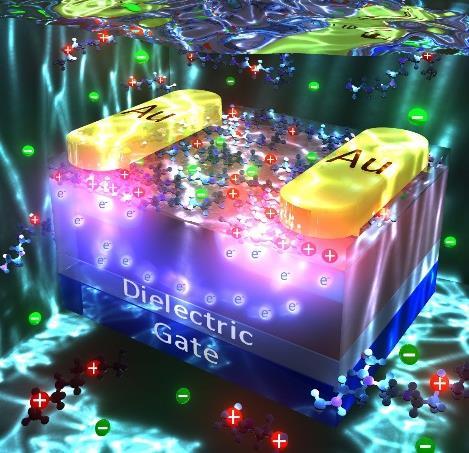
[October 31. 2019] Engineering energy band structures in organic and hybrid semiconductor devices using non-conjugated polyelectrolyte films
| Attachment '2' |
|---|
| Speaker | Asst. Prof. Bright Walker(Kyung Hee University) |
|---|---|
| Date | Thu. 31 October. 2019 |
| Time | 5:00pm |
| Venue | #331, Asan Hall, College of Science |
Engineering energy band structures in organic and hybrid semiconductor
devices using non-conjugated polyelectrolyte films
Conjugated polyelectrolytes have long been known as effective interfacial layers in a variety of organic optoelectronic devices such as LEDs, solar cells and transistors. More recently, molecular electrolytes have been shown to cause doping in organic semiconductors. This talk reviews recent work done using non?conjugated polyelectrolyte (NPE) layers to achieve controlled N-type and P-type doping at interfaces in organic and hybrid electronic devices. To enhance electron injection in n-type organic field-effect transistors (OFETs), NPE layers were interposed between a [6,6]-phenyl-C61-butyric acid methyl ester (PCBM) layer and Au electrodes. NPEs based on an ethoxylated polyethylenimine (PEIE) backbone with various counterions including Cl-, Br- and I- improved electron mobilities up to ~10-2cm2 V-1s-1 and yielded on-off ratios (I on /I off ) of 105 in PCBM OFETs. Ultraviolet photoelectron spectroscopy (UPS) revealed that all of the NPEs reduced electron injection barriers (φe) at the NPE/metal interface. Absorption measurements suggested n- doping of the PCBM. Regardless of the type of anion, thick NPE layers led tohigh conductivity in the films independent of gate bias, whereas thin NPE layers led to dramatically improved electron injection and performance. This mechanism was further applied in perovskite solar cells and light-emitting solar cells. Cationic and anionic polyelectrolytes were able to improve electron and hole injection in perovskite solar cells by analogous n-type and p-type doping mechanisms, respectively. These results demonstrate that thin electrolyte layers can be used to achieve controlled doping at interfaces in organic and hybrid semiconductors.

« Prev [October 31, 2017] New ways of vision: Protein structures in ...
[October 31, 2017] New ways of vision: Protein structures in ... 2017.10.25by 〈[September 19. 2019] Monitoring photo-chemical reaction with ... Next »
[September 19. 2019] Monitoring photo-chemical reaction with ... 2019.09.18by 〉-
Read More
[May 9. 2019] Chemistry in Molecular Vessels
Prof. Partha Sarathi MukherjeeThu. 9 May. 2019 -
Read More
[Mon. 13 Oct. 2016] Prof. Amir H. Hoveyda/Multicomponent Catalytic Synthesis of Organoboron Compounds for Scalable Natural Product Synthesis
Prof. Amir H. HoveydaMonday 13 October 2016 -
Read More
[Mon. 16 Oct. 2017] Prof. Kirk S. Schanze/Department of Chemistry, University of Texas at San Antonio, Texas, USA
Prof. Kirk S. SchanzeMon. 16 Oct. 2017 -
Read More
[Mon. 9 Jan. 2017] Prof. Sungwook Woo/Wyss Institute for Biologically Inspired Engineering, Harvard University, USA
Prof. Sungwook WooMon. 9 Jan. 2017 -
Read More
[November 14, 2017] Zero-Point Energy, Fluctuations, and Dissipation : A (Mostly) Quantum-Optical Perspective
Prof. Milonni, PeterNovember 14, 2017 -
Read More
[November 21. 2019] Biomedical applications of Pd-mediated cross coupling reactions
Hong Geun Lee(Seoul National University)Thu. 21 November. 2019 -
Read More
[November 28. 2019] Porous Silicon Nanomaterials for Biomedical Applications
Prof. Dokyoung Kim(KyungHee University)Thu. 28 November. 2019 -
Read More
[November 7. 2019] Student Host Colloquium/Unveiling cellular heterogeneity in early beige adipogenesis
Prof. DaeHee Hwang(Seoul National University)Thu. 7 November. 2019 -
Read More
[October 10, 2017] Novel Terahertz Spectroscopies
Director Mischa BonnTue, October 10, 2017 -
Read More
[October 15. 2019] A more sustainable chemistry with elemental sulfur
Dr. Thanh Binh Nguyen(Institut of Natural Product Chemistry)Tue. 15 October. 2019 -
Read More
[October 25, 2017] Ultrafast electron microscopy: applications in chemical and materials sciences
Dr. Byung-Kuk YooOctober 25, 2017 -
Read More
[October 31, 2017] New ways of vision: Protein structures in translational medicine and business development, my experience
Prof. Robert Huber(1988 Nobel Prize in Chemistry)October 31, 2017 -
Read More
[October 31. 2019] Engineering energy band structures in organic and hybrid semiconductor devices using non-conjugated polyelectrolyte films
Asst. Prof. Bright Walker(Kyung Hee University)Thu. 31 October. 2019 -
Read More
[September 19. 2019] Monitoring photo-chemical reaction with Raman spectroscopy
Prof. Choi Han-Kyu (Kunsan National University)Thu. 19 September. 2019 -
Read More
[Thu. 1 Dec. 2016] Prof. Sang-Yong Ju/Highly Pure Carbon Nanotubes sorted by a Flavin for Thin Film Transistor Applications
Prof. Sang-Yong JuThursday 1 December 2016 -
Read More
[Thu. 1 Jun. 2017] Prof. Jong-Man Kim/Department of Chemical Engineering, Hanyang University, Seoul, Korea
Prof. Jong-Man KimThu. 1 Jun. 2017 -
Read More
[Thu. 11 May. 2017] Prof. Andreas Heinrich/IBS Research, Center for Quantum Nanoscience, Seoul, South Korea
Prof. Andreas HeinrichThu. 11 May. 2017 -
Read More
[Thu. 12 Oct. 2017] Student Host Colloquium : Versatile Dendrimer-Encapsulated Nanoparticles for Analytical Applications
Prof. Joohoon KimThu. 12 Oct. 2017 -
Read More
[Thu. 13 Apr. 2017] Dr. Wan Ki Bae/Photoelectronic Hybrid Research Center, Korea Institute of Science and Technology, Seoul, Korea
Dr. Wan Ki BaeThu. 13 Apr. 2017 -
Read More
[Thu. 14 Sep. 2017] Prof. Dokyoung Kim/Department of Anatomy and Neurobiology, Kyung Hee University, Seoul
Prof. Dokyoung KimThu. 14 Sep. 2017
Designed by sketchbooks.co.kr / sketchbook5 board skin